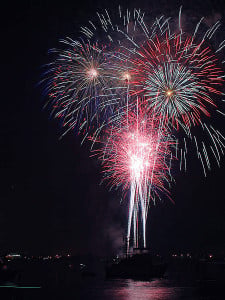In a Jul. 2, 2014 San Joaquin Valley Air Pollution Control District (Air District) two-page news release, on page 2 there is a graph. This graph shows July 4th – Independence Day – fine particulate matter pollution (PM 2.5) levels over a 24-hour period.
More specifically, the illustration shows the concentration in fine particle pollution on Jul. 4, 2011 in Turlock, California, a community located in the northern San Joaquin Valley (Valley). Normally, PM 2.5 is not the pollutant of concern in the Valley during summer months, but ozone is. Measured in micrograms per cubic meter of air, the national health standard for fine particulate matter is 35 micrograms per meter cubed (ug/m3).
Also from the graph, PM 2.5 readings between zero and approximately 15 micrograms per cubic meter correspond to an air quality index of 50 and below or air quality that is in the “good” range.
Well, to provide some perspective, at midnight (between Jul. 3rd and Jul. 4th) PM 2.5 was at roughly 20 micrograms per cubic meter or in the “moderate” range. By 6 a.m., air quality in this sense had improved with PM 2.5 dipping below 15 ug/m3, the corresponding quality of air being good. Between 6 a.m. and 8 p.m., air quality oscillated between good and moderate, the air being more good than it was moderate over that span of time.

By 10 p.m., PM 2.5 had reached levels that were very near 140 ug/m3 of air: or in the “very unhealthy” category, with a corresponding Air Quality Index Value of what appears to be in excess of 200. One hour later, at 11 p.m. that pollution peaked at a level greater than or equal to 150 ug/m3 with a corresponding Air Quality Index Value of at least 214. At midnight, PM 2.5 pollution levels slid back into the “unhealthy” range to right around 115 micrograms per cubic meter and a corresponding Air Quality Index Value of what looks to be right around 182. The title above the graph in question reads: “Typical PM pattern on July 4.”
Here are some of the harsh realities regarding July 4th fireworks activity in the Valley:
“Fireworks emit large quantities of PM, including soot, ash and metals, which cause serious health impacts, especially to people with existing respiratory conditions, elderly people and small children,” the San Joaquin Valley Air Pollution Control District notes.
The Air District further states, “Fine particulate matter – PM 2.5 – can invade the bloodstream and has been linked to heart attacks and stroke.”
And, depending on meteorological conditions and other factors, the spike in PM levels in Valley communities on account of Jul. 4 pyrotechnics displays could very well be adding to an already precarious area air condition so typical during summer months. We’re talking smog.
Meanwhile, in a Bakersfield Californian editorial, op-ed writer Lois Henry seems to have no qualms at all about sharing her perspective on the matter.
In “Lower the boom on this idiotic practice,” Henry outwardly, openly and quite publicly decried: “Fireworks = bad. They are dirty, costly and pose needless danger to our community.
“They need to be banned.”
The ban, though, that Henry alludes to is conditional.
Case in point: She wrote: “Professional shows, hey, I’m totally cool with those. But any kind of personal firework, ‘safe and sane’ or otherwise, needs to go.”
Henry goes on to state her reasons why, air pollution being among them.
“The soot from these Chinese- and Mexican-made smoke bombs routinely takes us over – way over – allowable limits for particulate matter (PM2.5). The allowable standard, per the EPA, is 35 micrograms per cubic meter of air over a 24-hour average. Last year’s Independence Day ‘celebration’ put us at 129 micrograms per cubic meter. In 2010, we were at 675 micrograms per cubic meter.”
Six-seventy-five: I can’t imagine.
With those kinds of exceedances, one would think this individual would flat-out be against all pyrotechnic activity, not just on the Fourth of July, but New Years, Chinese New Year and whenever else fireworks rocket skyward such as at baseball games, for example.
Again, Henry expressed why she feels the way she does.
“Limiting celebrations to professional shows would clear the field, so to speak, so enforcement teams would have an easier time going after offenders.”
That’s a far cry, or so it would seem, from her editorial’s third sentence, that “They need to be banned.”
Your thoughts?
– Alan Kandel